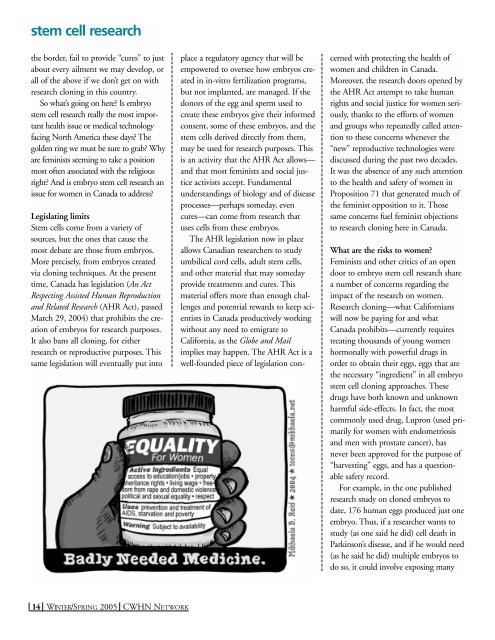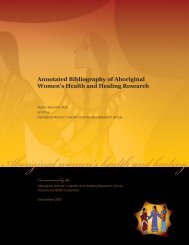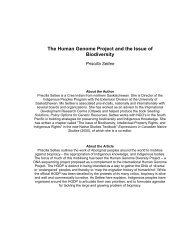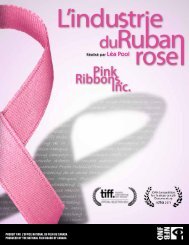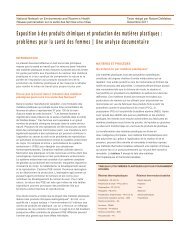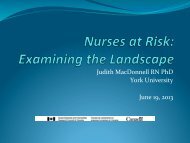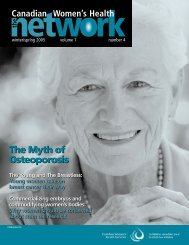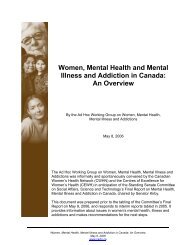NETWORK WIN00 - Canadian Women's Health Network
NETWORK WIN00 - Canadian Women's Health Network
NETWORK WIN00 - Canadian Women's Health Network
Create successful ePaper yourself
Turn your PDF publications into a flip-book with our unique Google optimized e-Paper software.
stem cell research<br />
the border, fail to provide “cures” to just<br />
about every ailment we may develop, or<br />
all of the above if we don’t get on with<br />
research cloning in this country.<br />
So what’s going on here? Is embryo<br />
stem cell research really the most important<br />
health issue or medical technology<br />
facing North America these days? The<br />
golden ring we must be sure to grab? Why<br />
are feminists seeming to take a position<br />
most often associated with the religious<br />
right? And is embryo stem cell research an<br />
issue for women in Canada to address?<br />
Legislating limits<br />
Stem cells come from a variety of<br />
sources, but the ones that cause the<br />
most debate are those from embryos.<br />
More precisely, from embryos created<br />
via cloning techniques. At the present<br />
time, Canada has legislation (An Act<br />
Respecting Assisted Human Reproduction<br />
and Related Research (AHR Act), passed<br />
March 29, 2004) that prohibits the creation<br />
of embryos for research purposes.<br />
It also bans all cloning, for either<br />
research or reproductive purposes. This<br />
same legislation will eventually put into<br />
place a regulatory agency that will be<br />
empowered to oversee how embryos created<br />
in in-vitro fertilization programs,<br />
but not implanted, are managed. If the<br />
donors of the egg and sperm used to<br />
create these embryos give their informed<br />
consent, some of these embryos, and the<br />
stem cells derived directly from them,<br />
may be used for research purposes. This<br />
is an activity that the AHR Act allows—<br />
and that most feminists and social justice<br />
activists accept. Fundamental<br />
understandings of biology and of disease<br />
processes—perhaps someday, even<br />
cures—can come from research that<br />
uses cells from these embryos.<br />
The AHR legislation now in place<br />
allows <strong>Canadian</strong> researchers to study<br />
umbilical cord cells, adult stem cells,<br />
and other material that may someday<br />
provide treatments and cures. This<br />
material offers more than enough challenges<br />
and potential rewards to keep scientists<br />
in Canada productively working<br />
without any need to emigrate to<br />
California, as the Globe and Mail<br />
implies may happen. The AHR Act is a<br />
well-founded piece of legislation concerned<br />
with protecting the health of<br />
women and children in Canada.<br />
Moreover, the research doors opened by<br />
the AHR Act attempt to take human<br />
rights and social justice for women seriously,<br />
thanks to the efforts of women<br />
and groups who repeatedly called attention<br />
to these concerns whenever the<br />
“new” reproductive technologies were<br />
discussed during the past two decades.<br />
It was the absence of any such attention<br />
to the health and safety of women in<br />
Proposition 71 that generated much of<br />
the feminist opposition to it. Those<br />
same concerns fuel feminist objections<br />
to research cloning here in Canada.<br />
What are the risks to women?<br />
Feminists and other critics of an open<br />
door to embryo stem cell research share<br />
a number of concerns regarding the<br />
impact of the research on women.<br />
Research cloning—what Californians<br />
will now be paying for and what<br />
Canada prohibits—currently requires<br />
treating thousands of young women<br />
hormonally with powerful drugs in<br />
order to obtain their eggs, eggs that are<br />
the necessary “ingredient” in all embryo<br />
stem cell cloning approaches. These<br />
drugs have both known and unknown<br />
harmful side-effects. In fact, the most<br />
commonly used drug, Lupron (used primarily<br />
for women with endometriosis<br />
and men with prostate cancer), has<br />
never been approved for the purpose of<br />
“harvesting” eggs, and has a questionable<br />
safety record.<br />
For example, in the one published<br />
research study on cloned embryos to<br />
date, 176 human eggs produced just one<br />
embryo. Thus, if a researcher wants to<br />
study (as one said he did) cell death in<br />
Parkinson’s disease, and if he would need<br />
(as he said he did) multiple embryos to<br />
do so, it could involve exposing many<br />
14 WINTER/SPRING 2005 CWHN <strong>NETWORK</strong>


